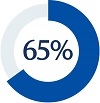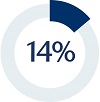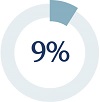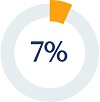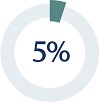There is an inverse relationship between age and interest in ETFs
Youth at the forefront
Having grown up just before the 2008 financial crisis, millennials tend to be “fee conscious” when it comes to financial services. Younger investors overall are typically tech savvy with a preference for “do-it-yourself” online tools in seeking out investments. It, therefore, shouldn’t be surprising that ETFs are enjoying increasing popularity among these age groups.
According to a study conducted by Logica Research on behalf of Charles Schwab,8 millennials have invested more of their portfolios in ETFs than other generations and a steady rate of growth is anticipated over the coming years. Millennial respondents hold more than 40% of their assets in ETFs, compared to a third for Gen X and less than 20% for baby boomers. Millennials expect that nearly half of their investments will be ETFs in five years compared to 40% for Gen X and 26% for boomers.
| |
Total |
Millennials |
Gen X |
Boomers |
| Average % of investments in ETFs today |
33% |
41% |
33% |
19% |
| Average % of investments in ETFs in five years |
40% |
48% |
40% |
26% |
A similar study by the Australian Securities Exchange (ASX)9 found that Next Gen investors—people aged 18 to 24 years—are drawn to ETFs more than shares. The study indicates that Next Gens are least likely to hold Australian shares directly (36% compared to 77% of retirees), but they are most likely to invest in ETFs (20% versus 7% of retirees).
| |
18 to 24 years |
Retirees |
| Hold shares directly |
36% |
77% |
| Hold ETFs |
20% |
7% |
Further confirming age differences in ETF ownership, a report published by the Investment Company Institute and Strategic Business Insights10 found that, while 7% of US households reported recent or ongoing ownership of ETFs, 21% of ETF-owning households were headed by a person younger than 40 years old, compared with 15% of retail mutual fund households. In addition:
- 36% of ETF households were headed by someone aged 60 or older, compared with 52% of retail mutual fund households
- ETF households tend to be more highly educated, with 66% reporting at least one college degree, compared with 56% of retail mutual fund households and 34% of all US households
- ETF households generally have higher incomes, although households across all income groups report ETF ownership.
| |
ETF
households |
Retail mutual
fund households |
| Headed by a person younger than 40 years old |
21% |
15% |
| Headed by a person 60 years or older |
36% |
52% |
1 25th Anniversary of the first ETF in Canada, ETFGI, March 9, 2015
2 History of ETFs, Vanguard, 2022
3 Canadian Regulators Approve World’s First Bitcoin ETF for Individual Investors, EKB, March 14, 2021
4 ETFGI reports that assets invested in the global ETFs industry reached a new milestone at the end of 2023, ETFGI, January 16, 2024
5 EPFR Data Reports Total Global ETF Assets Exceed $10 Trillion, EPFR, Informa Financial Intelligence, November 11, 2021
6 ETF and Index Funds Report—Canada, Investor Economics, Q2 2022
7 What risks are there in ETFs, etf.com
8 ETFs and Beyond, Charles Schwab, September 2022
9 ASX Australian Investor Study 2020, Australian Securities Exchange, September 2020
10 A Close Look at ETF Households Investment Company Institute and Strategic Business Insights, October 1, 2018

